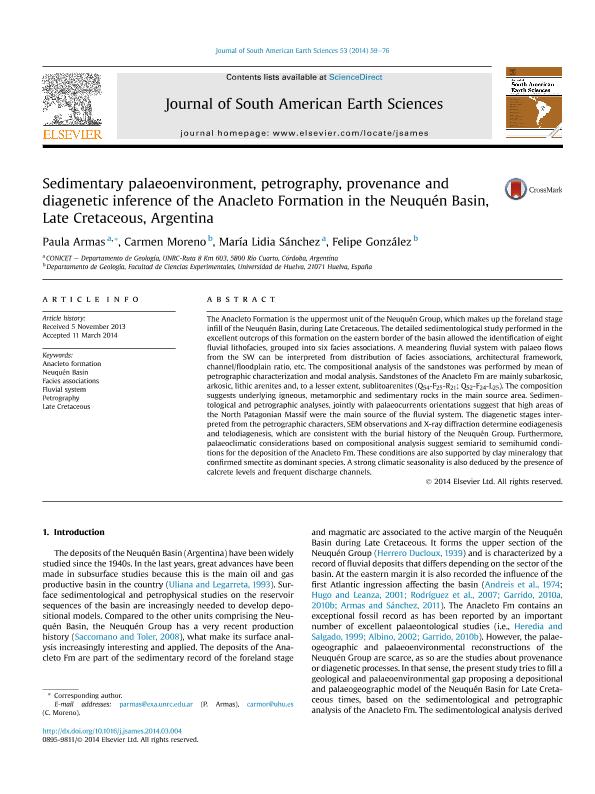Mostrar el registro sencillo del ítem
dc.contributor.author
Armas, María Paula

dc.contributor.author
Moreno, Carmen
dc.contributor.author
Sanchez, Maria Lidia

dc.contributor.author
González, Felipe
dc.date.available
2018-01-25T22:13:29Z
dc.date.issued
2014-04
dc.identifier.citation
Armas, María Paula; Moreno, Carmen; Sanchez, Maria Lidia; González, Felipe; Sedimentary palaeoenvironment, petrography, provenance and diagenetic inference of the Anacleto Formation in the Neuquén Basin, Late Cretaceous, Argentina; Elsevier; Journal of South American Earth Sciences; 53; 4-2014; 59-76
dc.identifier.issn
0895-9811
dc.identifier.uri
http://hdl.handle.net/11336/34658
dc.description.abstract
The Anacleto Formation is the uppermost unit of the Neuquén Group, which makes up the foreland stage infill of the Neuquén Basin, during Late Cretaceous. The detailed sedimentological study performed in the excellent outcrops of this formation on the eastern border of the basin allowed the identification of eight fluvial lithofacies, grouped into six facies associations. A meandering fluvial system with palaeo flows from the SW can be interpreted from distribution of facies associations, architectural framework, channel/floodplain ratio, etc. The compositional analysis of the sandstones was performed by mean of petrographic characterization and modal analysis. Sandstones of the Anacleto Fm are mainly subarkosic, arkosic, lithic arenites and, to a lesser extent, sublitoarenites (Q54-F25-R21; Q52-F24-L25). The composition suggests underlying igneous, metamorphic and sedimentary rocks in the main source area. Sedimentological and petrographic analyses, jointly with palaeocurrents orientations suggest that high areas of the North Patagonian Massif were the main source of the fluvial system. The diagenetic stages interpreted from the petrographic characters, SEM observations and X-ray diffraction determine eodiagenesis and telodiagenesis, which are consistent with the burial history of the Neuquén Group. Furthermore, palaeoclimatic considerations based on compositional analysis suggest semiarid to semihumid conditions for the deposition of the Anacleto Fm. These conditions are also supported by clay mineralogy that confirmed smectite as dominant species. A strong climatic seasonality is also deduced by the presence of calcrete levels and frequent discharge channels.
dc.format
application/pdf
dc.language.iso
eng
dc.publisher
Elsevier

dc.rights
info:eu-repo/semantics/openAccess
dc.rights.uri
https://creativecommons.org/licenses/by-nc-nd/2.5/ar/
dc.subject
Anacleto Formation
dc.subject
Neuquén Basin
dc.subject
Facies Associations
dc.subject
Fluvial System
dc.subject.classification
Geología

dc.subject.classification
Ciencias de la Tierra y relacionadas con el Medio Ambiente

dc.subject.classification
CIENCIAS NATURALES Y EXACTAS

dc.title
Sedimentary palaeoenvironment, petrography, provenance and diagenetic inference of the Anacleto Formation in the Neuquén Basin, Late Cretaceous, Argentina
dc.type
info:eu-repo/semantics/article
dc.type
info:ar-repo/semantics/artículo
dc.type
info:eu-repo/semantics/publishedVersion
dc.date.updated
2018-01-25T20:48:58Z
dc.journal.volume
53
dc.journal.pagination
59-76
dc.journal.pais
Países Bajos

dc.journal.ciudad
Amsterdam
dc.description.fil
Fil: Armas, María Paula. Universidad Nacional de Rio Cuarto. Facultad de Ciencias Exactas, Fisicoquímicas y Naturales. Departamento de Geología; Argentina. Consejo Nacional de Investigaciones Científicas y Técnicas; Argentina
dc.description.fil
Fil: Moreno, Carmen. Universidad de Huelva; España
dc.description.fil
Fil: Sanchez, Maria Lidia. Universidad Nacional de Rio Cuarto. Facultad de Ciencias Exactas, Fisicoquímicas y Naturales. Departamento de Geología; Argentina. Consejo Nacional de Investigaciones Científicas y Técnicas; Argentina
dc.description.fil
Fil: González, Felipe. Universidad de Huelva; España
dc.journal.title
Journal of South American Earth Sciences

dc.relation.alternativeid
info:eu-repo/semantics/altIdentifier/doi/http://dx.doi.org/10.1016/j.jsames.2014.03.004
dc.relation.alternativeid
info:eu-repo/semantics/altIdentifier/url/https://www.sciencedirect.com/science/article/pii/S0895981114000352
Archivos asociados
